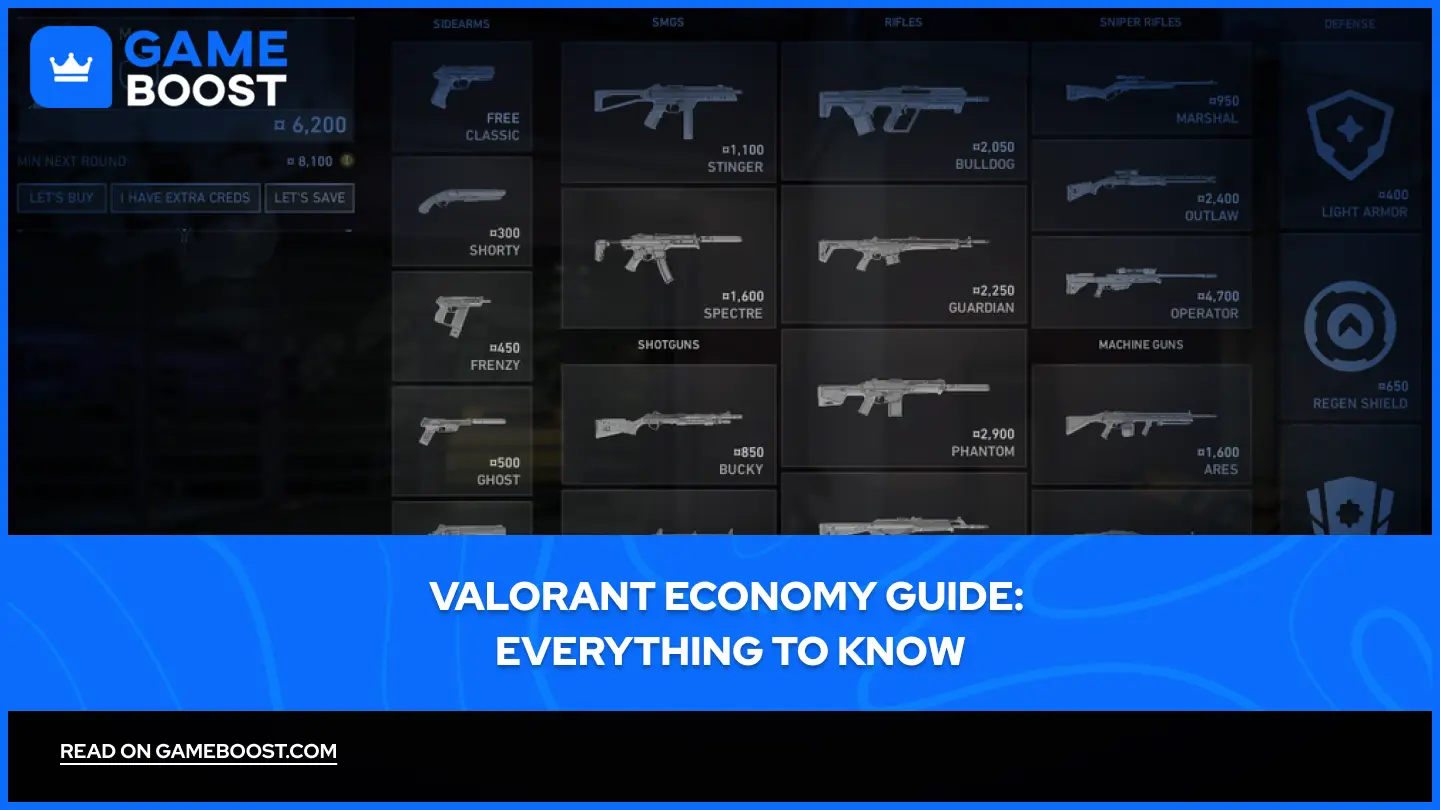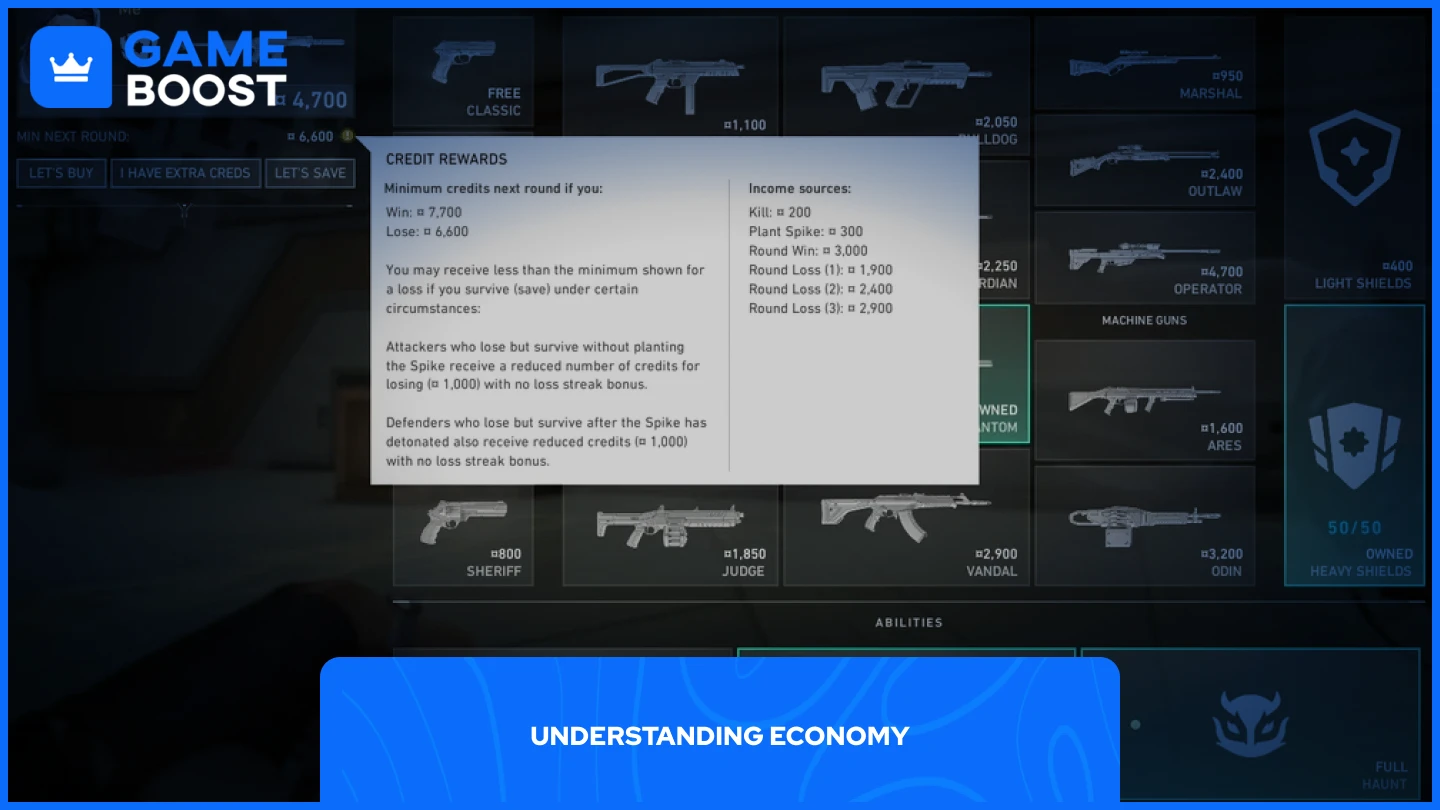

Valorant Economy Guide: Everything to Know

Valorant's economy system controls how you earn, spend, and manage credits during matches. The economy affects your decisions about which weapons, armor, and utilities you can buy each round, when your team should save money or go for a full buy, and how to plan purchases across multiple rounds.
Misjudging your team's economy leads to forced buys you can't support. This creates a cycle where you lose rounds badly and enter long stretches with inadequate equipment. Teams that understand economic flow gain significant advantages over those that make poor financial decisions.
The system involves credit rewards from kills, round wins, losses, and objective completions. Loss bonuses help losing teams stay competitive, while winning teams must manage their resources to maintain their advantage. In this article, we'll explain everything about Valorant's economy, highlighting when you should save, full buy, and make strategic decisions that keep your team properly equipped throughout the match.
Also Read: How to Add Friends in Valorant: Step-by-Step Guide
Understanding Economy

For each round in Valorant, you earn credit rewards that determine what equipment you can purchase. These credits buy weapons, abilities, and armor to prepare for the upcoming round. The reward system works as follows:
Kill: 200 Credits
Plant Spike: 300 Credits
Round Win: 3,000 Credits
Round Loss (1): 1,900 Credits
Round Loss (2): 2,400 Credits
Round Loss (3+): 2,900 Credits
The longer you lose consecutive rounds, the more credits you earn through loss bonuses. This system helps losing teams stay competitive by providing increased purchasing power after multiple defeats.
Defusing the spike does not grant any bonus credits, though it wins the round and provides the standard 3,000 credit round win bonus. All players start each half with 800 credits, and the maximum credit cap is 9,000. Players who survive a round keep their equipment for the next round, while eliminated players lose their gear but retain unused abilities.
The loss bonus system resets once a team wins a round, returning the losing team's credit bonus back to the base 1,900 credits for their next loss. This economic structure creates strategic decisions around when teams should save money, force buy with limited resources, or invest in full equipment purchases.
Also Read: How to Check Your Valorant Purchase History
Types of Rounds
Teams choose different buying strategies based on their credit situation and round objectives. Your team's financial state determines which approach maximizes your chances of winning while maintaining economic stability.
The main round types include:
Eco Round
Half Buy
Force Buy
Full Buy
Bonus Round
Anti-Eco Round
Anti-Force Round
Each strategy serves specific purposes depending on your team's credits, the enemy's economy, and the match situation. Understanding when to implement each approach prevents wasteful spending and maintains purchasing power across multiple rounds.
1. Eco Round
Eco rounds involve spending minimal credits to save money for future purchases. Players typically buy basic pistols or use their starting Classic, avoiding expensive weapons and utilities. The main goal focuses on accumulating credits for stronger equipment in subsequent rounds rather than winning the current round.
2. Half Buy
Half buys involve purchasing mid-tier weapons and light armor while saving enough credits for a full buy in the next round. Players typically buy Spectres, Stingers, or Sheriffs with light shields. This strategy allows teams to compete in the current round without risking their future buying power.
3. Force Buy
Force buying happens when teams spend all available credits despite lacking funds for proper full equipment. Players purchase the best possible loadout within their budget constraints, typically including light armor and SMGs or rifles without full utility.
Force buys occur during critical situations such as match point, the last round before halftime, or when teams need to break losing streaks. Winning a force buy can level the economic playing field, while losing often forces teams back into eco rounds.
Common force buy situations include rounds where losing resets the economy to 1,500 credits or below, when teammates cannot afford half buys in the following round, or when full buys are guaranteed next round regardless of outcome.
Also Read: How to Mute Other Players in Valorant
4. Full Buy
Full buy rounds involve purchasing the best available equipment, including rifles, full armor, and complete utility sets. Teams typically need 3,900-4,500 credits per player for effective full buys. These rounds provide maximum combat effectiveness and the highest chance of winning.
Players prioritize weapons over abilities when credits are limited, as rifles and full shields create the foundation for round victories. The minimum requirement involves 3,900 credits for a rifle and heavy armor combination.
5. Bonus Round
Bonus rounds occur after winning the first two rounds of a half. Teams carry over weapons from the second round, typically SMGs or shotguns, without making major new purchases. This strategy influences the enemy's economy while conserving credits for future rounds.
6. Anti-Eco Round
Anti-eco rounds respond to anticipated enemy eco strategies. Instead of saving alongside the opposing team, players spend credits to maximize their equipment advantage. Teams purchase weapons and utilities effective against close-quarters combat and aggressive plays, maintaining control to counter eco tactics.
7. Anti-Force Round
Anti-force rounds respond to anticipated enemy force-buy strategies. Teams expect opponents to spend all available credits on aggressive equipment and adjust their purchases to counter close-quarters combat and unexpected aggression.
Teams buy weapons and utilities that handle aggressive tactics effectively, maintaining control and discipline to counter the enemy's force-buy approach. Successfully countering a force-buy can devastate the enemy's economy and provide stronger economic advantages.
Final Words
Valorant's economy system determines match outcomes more than individual skill. Teams that coordinate purchases, track enemy credits, and make disciplined decisions consistently outperform mechanically superior opponents. Save during eco rounds, use half buys to stay competitive, and force buy only during critical moments. Monitor enemy spending patterns and communicate with teammates before purchasing to build the momentum needed for victory.
“ GameBoost - The All-In-One Gaming Services Platform with a mission to truly change the life of every day gamers. Whether you're looking for Currencies, Items, High-Quality Accounts or Boosting, we've got you covered! ”





